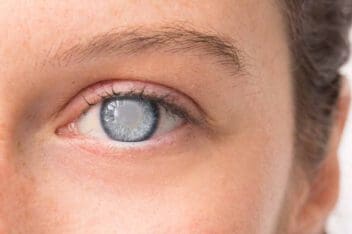How UV Radiation Affects the Eyes: Risks, Prevention & More
Home / Eye Conditions & Eye Diseases /
Last Updated:
Ultraviolet (UV) light is well known as a cause of skin cancer. This wavelength of radiation can damage your eyes too. But you can protect your eyes from the sun’s rays, guarding against potential blindness.
Table of Contents
There are three types of UV light, with UVA and UVB rays reaching the surface of the earth and causing the most damage to your eyes. Several types of eye disease are caused by UV light, from the equivalent of a sunburn on your cornea to conjunctival cancer.
The best way to protect your eyes is to work with your eye doctor to get the right pair of sunglasses. Understanding your individual risks from UV radiation exposure can help you manage your eye health too.
Ultraviolet Light: A Wavelength That Harms Your Eyes

Ultraviolet (UV) light is a type of radiation in the combination of energy wavelengths making up sunlight. Thanks to health campaigns, many of us know that we should wear sunscreen to protect our skin from damage and potential skin cancer. Even indirect sunlight can cause damage to your skin cells, and protecting them is important.
UV light also damages cells in your eyes, particularly on your retina. If you are in direct sunlight too long while enjoying warm weather or while outside skiing in the winter, you can get the equivalent of a sunburn on your eyes. This can damage many sensitive parts of your eye. If you repeatedly damage these tissues, you can develop chronic vision problems or blindness.
You deserve clear vision. We can help.
With 135+ locations and over 2.5 million procedures performed, our board-certified eye surgeons deliver results you can trust.
Your journey to better vision starts here.
Protecting your eyes from strong UV light reduces your risk of cataracts, retinal damage, and eye cancer. Finding the right sunglasses and learning how to protect your eyes from other wavelengths of light will help you keep your vision healthy for a long time.
UV Radiation Sources & Your Eyes
Although UV radiation is not visible to the eye like colors are, this wavelength can still damage your sight. There are three types of UV light, two of which reach the surface of the earth and can damage your skin or eyes.
- UVA: This type has the longest wavelength. It harms your central vision, damaging the macula, or central part of the retina, at the back of your eye.
- UVB: This type has a shorter wavelength, most of which gets trapped by the earth’s ozone layer. UVB rays that make it to the earth’s surface can damage the front of your eye, like your cornea and lens, causing damage to these clear, surface parts of your eye.
- UVC: This type has the shortest wavelength. It does not reach the earth’s surface because all of it is trapped by the ozone layer.
You may assume that your highest risk of UV radiation exposure is during the warm, summer months, when there is no cloud cover and you are more likely to be outside. The truth is, you can be exposed to UV light whenever you are outside, even if it is a cloudy day.
Ways you can be exposed to UV light in colder months include:
- Sunlight reflected off snow.
- Tanning booths.
- Mercury vapor lights, which may still be in some school gyms or stadiums.
- Some types of halogen, fluorescent, or incandescent lights.
- Some types of lasers.
If you take certain medications, like birth control, antibiotics, or some benzoyl peroxide products, you may be more sensitive to UV radiation in the eyes or on your skin. Be sure to protect your eyes more often while you take these medications. Don’t leave the house without protective sunglasses, and choose to wear a hat, even during the colder months.
Eye Diseases Associated With UV Radiation

Various diseases of the eye are associated with UV radiation:
Photokeratitis
This is essentially a sunburn on the surface of your eye. Long hours at the beach, working outside, or having sunlight reflected into your eyes from pale pavement or snow can lead to this condition. In winter, photokeratitis is called snow blindness, as it is often due to spending long hours outside in the snow.
Severe photokeratitis can cause temporary vision loss. Milder forms can cause blurry vision and eye pain.
Pterygium
This is a bump or wedge of flesh that forms on the white part of your eye, typically from the inner corner, radiating out. Pterygia are not harmful to your vision unless they radiate out far enough to cause your cornea to change shape, which could cause a refractive error like nearsightedness.The pterygium may itch, cause redness or mild inflammation on the white part of your eye, or cause you to feel like something is constantly stuck in your eye. If the pterygium is disruptive to your life or causes your vision to change, you can have it surgically removed.
Cataracts
Sun damage from UVB that harms your lens can damage the proteins in this clear structure. Over time, damaged proteins may clump together, causing dark spots, cloudy areas, or white clumps. These are cataracts.
Your optometrist or ophthalmologist will notice these developing in your lens before you lose any significant amount of vision, as long as you go to regular eye exams. Once you start developing cataracts, there is no way to slow them down or stop them.
Your eye doctor will monitor the cataract’s progress and help to manage refractive errors with stronger glasses prescriptions. Eventually, you will need to have the lens of your eye removed and replaced with an artificial lens. Your eye doctor will advise you when surgery is needed.
Macular degeneration
This is a leading cause of vision loss among older Americans, affecting about 10 million people. The macula is the central part of the retina, and if this area is damaged, your central vision will degrade.
Drusen, or deposits of protein, collect on the retina and starve it of oxygen. It may lead to new blood vessels entering the macula to supply more oxygen to the area, but this can damage the sensitive retina further.
Conjunctival cancer
Eye cancer, especially on the surface of the eye (the conjunctiva, which is the film over the sclera or the white part of your eye) is increasingly common among older adults. Like skin cancer, conjunctival cancer may be associated with increased sun exposure without appropriate protection.
You deserve clear vision. We can help.
With 135+ locations and over 2.5 million procedures performed, our board-certified eye surgeons deliver results you can trust.
Your journey to better vision starts here.
Finding the Right Pair of Sunglasses to Protect Your Eyes From UV Light
People often wear sunglasses on bright days to reduce glare so they do not squint, but wearing sunglasses that protect your eyes from UV radiation can preserve your vision. Specifically, sunglasses with lenses rated to protect against UVA and UVB rays, and that wrap around your head to fully protect your central and peripheral sight, are the best type of sunglasses to wear.
- Block at least 99 percent of UVA and UVB rays.
- Screen between 75 and 90 percent of visible light.
- Have lenses without distortions that would refract light into your eyes.
- Have lenses that have even, matching color throughout them.
- Have lenses that are gray, rather than tinted another color, so you can properly recognize colors.

Wearing the wrong kind of sunglasses can actually increase your risk of vision damage. Some inexpensive types of sunglasses may claim they protect against UV light, but if the tag does not say they protect against both UVA and UVB rays, it is unlikely that the lenses reflect UV light away from your eyes. You could think you have good protection for your vision, but you do not.
If the lenses are dark, your pupils will get a little larger in response to having less light. This means that more wavelengths in the nonvisual spectrum, like UVA and UVB rays, can enter your eyes and cause damage to your retina.
To ensure you get the best protection from your sunglasses, get a recommendation from your optometrist or ophthalmologist. Your eye doctor’s office may even sell sunglasses and can recommend the best pair for your eyes.
Understand UV Light & Other Light to Keep Your Eyes Healthy
In addition to wearing proper eye protection, you can manage your exposure to UV light by checking the Environmental Protection Agency’s (EPA) UV forecasts based on your zip code. This will tell you how much UV you can expect during the course of the day. You can manage your risk by spending less time outdoors on days with high levels of UV rays.
Although there are risks from being exposed to too much UV radiation, getting some exposure to this light wavelength is important for your health. UVB rays, in particular, help your skin produce vitamin D, which keeps your bones and muscles healthy, along with calcium.
This benefit is only of going outside for sunlight. There are no tanning beds or other devices approved by the U.S. Food and Drug Administration (FDA) to help your skin produce more vitamin D from UV light.
If you have had cataract surgery, you have light-colored eyes, or you have a family history of eye diseases like cancer or cataracts, it is even more important for you to find the right pair of sunglasses to protect your eyes. It’s best to avoid tanning beds altogether, but if you do use them, be sure that you wear the special light-protecting goggles provided. If you participate in winter sports in the snow, be sure you have goggles or a visor that offers UV protection.
UV radiation has immense effects on the eyes, causing significant damage if the eyes are unprotected. Make it a daily habit to protect your eyes from the sun any time you are outdoors, regardless of the weather.
You deserve clear vision. We can help.
With 135+ locations and over 2.5 million procedures performed, our board-certified eye surgeons deliver results you can trust.
Your journey to better vision starts here.
References
- Ultraviolet (UV) Radiation. (April 2019). U.S. Food and Drug Administration (FDA).
- The Sun and Your Eyes. (June 2019). Skin Cancer Foundation.
- How Can UV Rays Damage Your Eyes? Prevent Blindness.
- UV Radiation: Protecting Your Eyes from Solar Radiation. American Optometric Association (AOA).
- Eyes Need Sun Protection, Too. (May 2019). UCI Health.
This content is for informational purposes only. It may have been reviewed by a licensed physician, but is not intended to serve as a substitute for professional medical advice. Always consult your healthcare provider with any health concerns. For more, read our Privacy Policy and Editorial Policy.
